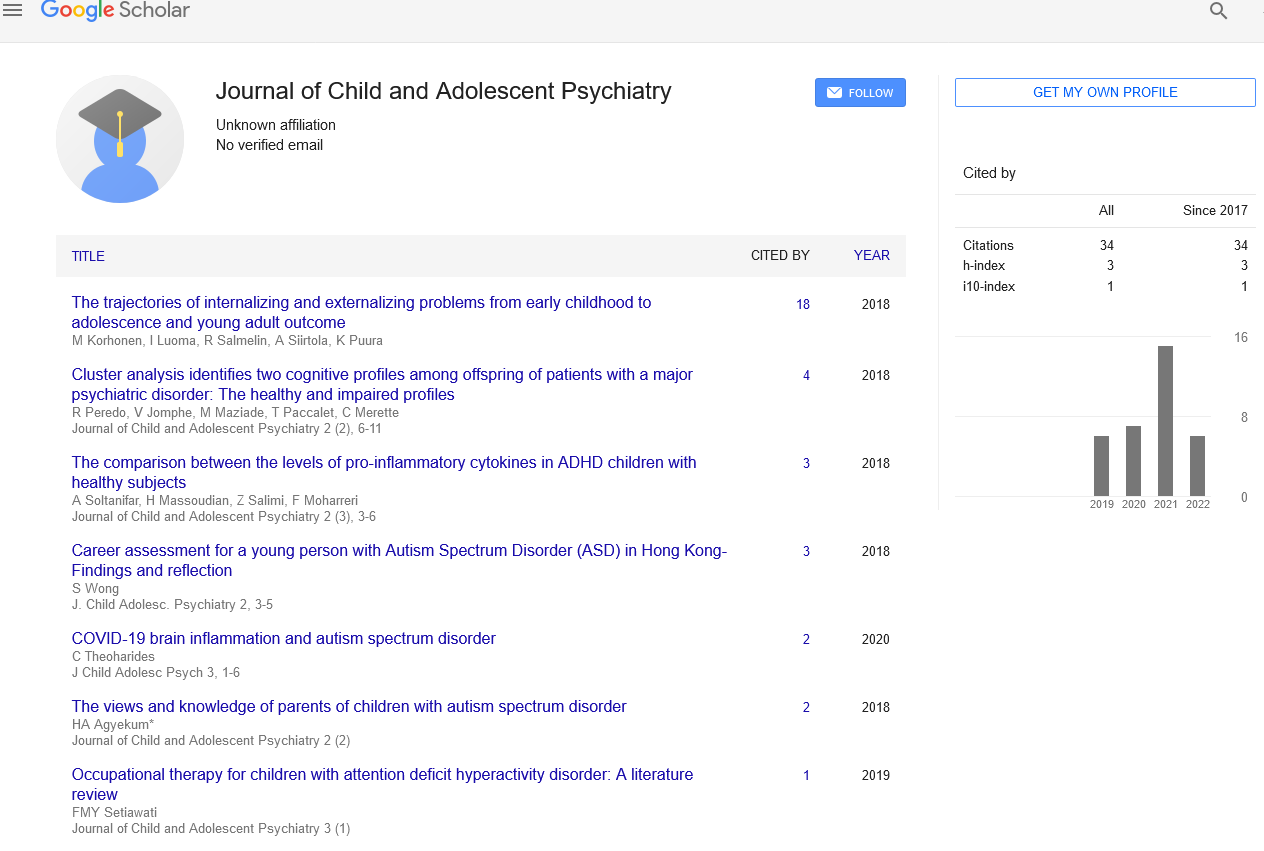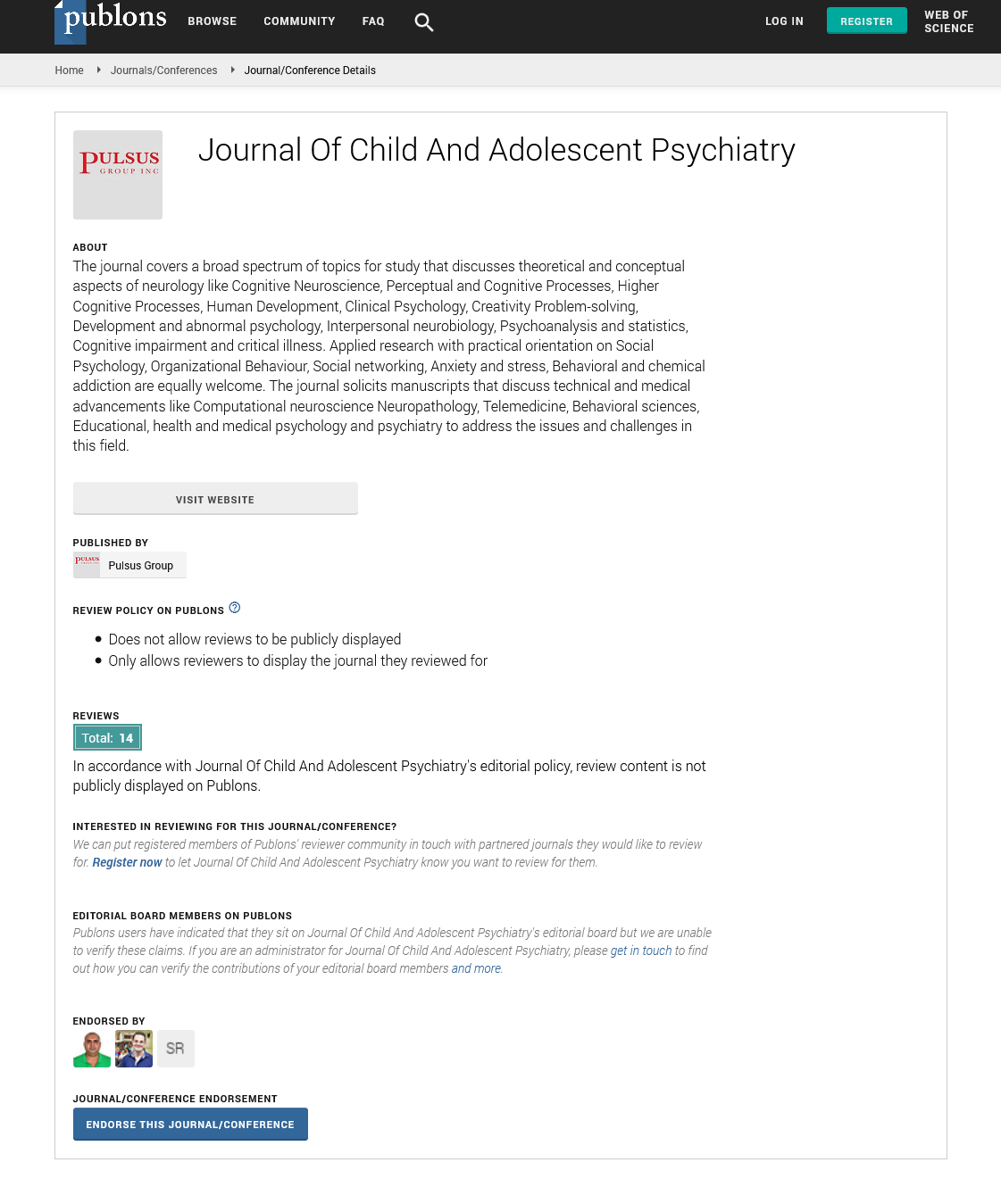Informatics era and somatic, psycho-behavioral and psychiatric impact on the child and teenager
Received: 21-Nov-2017 Accepted Date: Nov 22, 2017; Published: 30-Nov-2017
Citation: Rizeanu S. Informatics era and somatic, psycho-behavioral and psychiatric impact on the child and teenager. J Child Adolescent Psych 2017;1(1):4-5.
This open-access article is distributed under the terms of the Creative Commons Attribution Non-Commercial License (CC BY-NC) (http://creativecommons.org/licenses/by-nc/4.0/), which permits reuse, distribution and reproduction of the article, provided that the original work is properly cited and the reuse is restricted to noncommercial purposes. For commercial reuse, contact reprints@pulsus.com
We live in a world dominated by an informational avalanche propagated through media channels: television, Internet, computer games. We all appreciate the benefits, but the costs are hard to anticipate. The most exposed group is represented by children and adolescents. Currently, we can talk about the computer’s harmful effects on the physical state of children and adolescents, psycho-cognitive development, deterioration of interhuman relationships, and distortion of perception of reality Gillespie [1].
The harmful effects caused in the somatic area by prolonged stagnant static positions behind the computer, especially during the development and formation of the child, cause kickbacks, scoliosis and obesity (through sedentary and uncontrolled eating). The effect of the cathode rays emitted by the monitor increased the incidence of myopia at children and the appearance of photosensitive epilepsy Ellahi et al. [2].
The effects of inducing a semi-hypnotic state in the brain due to the beta waves (involved in thinking, analysis and decision processes) turning into predominantly alpha waves (responsive to relaxation) and theta waves (specific to sleep) are well known. The right hemisphere is activated to the detriment of the left one (responsible for logical thinking, critical analysis and organization). The right part of the brain treats the received data uncritically, and the semi-hypnosis state allows information to be entered directly into the subconscious. The “right” brain causes emotional rather than rational responses. In addition, these regions of the brain cannot distinguish between reality and images produced (a function performed by neo-cortex), so it interprets the information as if it were real. For this reason, they will tend to have an unrealistic and incorrect perspective on the perception of reality. Cerebral imbalances in left hemisphere operation and lack of normal neural network development affect logical and analytical thinking. In a hypnotic state, the information we are exposed to is unloaded directly into the subconscious, where it will influence existing convictions and create new concepts without the subject being aware of it. The American psychologists have demonstrated the involvement of an addiction-like mechanism, caused in fact by the growth of endorphins in the case of addiction to video or TV games Zastrow [3]. Scintillation of a monitor and fast image succession inhibit melatonin, the hormone responsible for sleep induction. For this reason, many children and adolescents have difficulties in falling asleep. The sleep-watch cycle has reversed - sleep deprivation, exactly in their period of growth, has major and complex negative effects, such as physical development and chronic fatigue syndrome. Over 50% of children in Western countries, and not only, have learning difficulties, low ability to listen, to understand and to remember the material presented Lobe et al. [4]. Low ability of consistent reflection of facts and ideas in speech and writing, the difficulty of understanding longer phrases or more complex grammatical structures are commonly identified today in children and adolescents.
We must also signal mental and behavioral modeling by activating the psychological mechanisms of imitation and by imposing models in the individual and collective mentality. Some behaviors are being cultivated with particularly strong effects in shaping the youth consciousness and behavior horizon.
Violence on the small screen and video games brings violence into the real world. Young people became more and more impulsive, unable to control their violent impulses, to the detriment of prosocial behavior. This has become a constant characteristic of the behavior of generations raised with TV & PC in excess.
The affective climate of the family has lost its emotional and moral support for child development. Long-term use of the computer damages the value system and interaction with others, generating behavioral disturbances, social withdrawal and introversion. It also influences personality traits, family dynamics and communication between family members.
Longitudinal studies reveal the fact that personality traits, family dynamics, communication with children and adolescents are influenced. M. Weinstein [5], Professor of Political Science at Purdue University, points out that technology has damaged the value system and social functioning in adolescents. TV generates a passive mental attitude, a delay in information processing, thinking, and is a major factor in inducing hyperactivity. Neuropsychologists show that extreme agitation, inability to sit quietly, low tolerance to frustration, excessive impulsivity are conditions that arise from repeated exposure, in conjunction with the increase in viewing time. Excessive hyperactivity, impulsiveness, low motivation for learning, inability to concentrate are some of the worrying issues of the new generation. Numerous studies show that cortical diseases caused by excessive TV viewing or video games result in the appearance of ADHD syndrome (weakening of fundamental mental capabilities: focusing attention, short-term memory, creative imagination, motivation to undertake an effort-seeking action).
A multidisciplinary research team from Romania, comprising psychiatrists, psychologists, psycho-pedagogues, IT engineers and statisticians organized between 2006 and 2007 the study “Identification of risk factors and intervention strategies in social and educational interference in computer use in children and teenagers” Chele [6]. The study was conducted on a total of 543 students aged between 12 and 18, and the results showed that long-term use of the computer caused depression to occur in a total of 8 pupils, respectively 25%, and Attention Deficit Hyperactivity Disorder (ADHD) to a total of 6 students, representing 18.75% of the lot.
People who use computers excessively are irritable, have low tolerance to frustration, are in a constant internal tension, dominated by impatience and anxiety. The computer acts as a means by which they discharge these inner states but at the same time increases them due to the negative health effects. These people are more timid, show physical inconvenience, insecurity, vulnerability, irritation. Many hours spent behind the computer indicate a significantly reduced involvement in other activities with somatic consequences (obesity, venous thrombosis, etc.) as well psychological (social withdrawal, mental fatigue, social phobia, hyperkinetic disorder).
REFERENCES
- Gillespie RM. The physical impact of computers and electronic game use on children and adolescents, a review of current literature. Work. 2002;18(3):249-59.
- Ellahi A, Khalil MS, Akram F. Computer users at risk: Health disorders associated with prolonged computer use. E3 J Business Management and Economics. 2011;2(4):171-182.
- Zastrow M. News Feature: Is video game addiction really an addiction? Proc Natl Acad Sci USA. 2017;114(17):4268-72.
- Lobe B, Livingstone S, Olafsson K, et al. Cross-national comparison of risks and safety on the internet. Initial analysis from the EU Kids Online survey of European children. London: EU Kids Online, LSE. 2011
- Weinstein, M.A. Culture/Flesh: Explorations of Postcivilized Modernity. London: Rowman & Littlefield. 1995.
- Chele G.E. Utilizarea îndelungat a calculatorului la copi adolescent: Factor de risk condiie premorbid. Doctoral Thesis. Iai: UMF„ Grigore T. Popa”. 2010.






